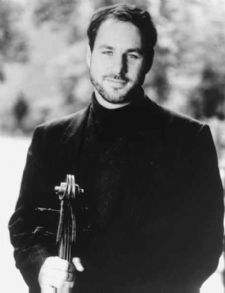|
Symphony
SRS SEASON ENDS WITH RESOUNDING TA-TA-TA-BANG
by Terry McNeill
Sunday, June 1, 2025
Symphony
YOUTHFUL VIRTUOSITY ON DISPLAY AT USO'S MAY CONCERTS
by Peter Lert
Saturday, May 17, 2025
Symphony
MYSTICAL PLANETS AND LIVELY GERSHWIN ORTIZ AT FINAL SRS CONCERT
by Peter Lert
Sunday, May 4, 2025
Symphony
VSO'S CONCERT MUSIC OF TIME, MUSIC OF PLACE
by Peter Lert
Sunday, April 27, 2025
Choral and Vocal
VOCAL ELEGANCE AND FIRE AT THE 222'S RECITAL APRIL 26
by Pamela Hicks Gailey
Saturday, April 26, 2025
CANTIAMO SONOMA SINGS AN INSPIRED GOOD FRIDAY MOZART REQUIEM CONCERT
by Pamela Hicks Gailey
Friday, April 18, 2025
DRAMATIC SHOSTAKOVICH SYMPHONY CLOSES PHILHARMONIC'S 25TH SEASON
by Terry McNeill
Sunday, April 13, 2025
LARGE COLLEGE OF MARIN AUDIENCE GREETS STOPHER ARTISTRY
by Terry McNeill
Saturday, April 5, 2025
Chamber
FRISSON DELIVERS SHIVERS OF DELIGHT
by Abby Wasserman
Sunday, March 30, 2025
OLD AND MOSTLY NEW IN SRS MARCH CONCERT IN WEILL
by Peter Lert
Saturday, March 22, 2025
|
 |
 Gary Hoffman |
THE SUITE SMELL OF SUCCESS
by Steve Osborn
Sunday, April 19, 2009
A ballet suite is not a symphony, but don’t tell that to Bruno Ferrandis. Throwing caution to the winds, Maestro Ferrandis programmed not one but two ballet suites for the April 19 concert by the Santa Rosa Symphony, opening with selections from Aram Khachaturian’s Gayane and devoting the entire second half to a suite of suites from Sergei Prokofiev’s Cinderella. Only an obscure, two-movement cello concerto by Nikolai Miaskovsky broke the long string of dance numbers.
Listening to a ballet suite without the requisite ballerinas and ballerinos is a bit like watching a movie with the sound off. You can infer what’s going on, but it sure would be helpful to have a human voice or a dancer confirm your suspicions. On the other hand, the dialogue or dance steps you imagine in the absence of same can be more engaging than the real thing.
From the summary of Gayane given in the program notes, imagining the ballet may be preferable to watching an actual performance. The Stalinist-era plot concerns a young village wife who conspires with a Soviet guard to foil her evil husband’s schemes against the people.
From the four acts of this drama, Ferrandis excerpted only three pieces, starting with the “Dance of the Rose Maidens,” which the orchestra played crisply and at a brisk pace. The ensuing “Lullaby” began with a lovely oboe solo, followed by contributions from the other woodwinds. Just to their right sat a saxophonist, who joined in during the last number, the famous “Saber Dance,” beloved of circuses and cartoons. The playing here was saber-rattling, if a touch sedate.
Next up was the Miaskovsky Cello Concerto, composed at the tail end of World War II. This rarely played work (at least in the U.S.) exhibits considerable anguish, perhaps because of the composer’s experiences during the war. Whatever their source, the concerto’s elegiac moods found a sympathetic interpreter in soloist Gary Hoffman. Despite playing from a score, he built strong rapport with the audience and delivered a convincing performance in every respect, save for occasional intonation problems on some of the trickier double stops.
Hoffman’s score became the unexpected center of attention when the cellist arrived on stage and discovered that a resident poltergeist had moved the ceiling spotlight that should have illuminated his music stand. “We need light,” Ferrandis pleaded, to no avail. The solution was to move Hoffman back toward the orchestra until he came in range of another spotlight, which was fine, except that now the second violins had to move back. No dominoes fell beyond the string section, however.
The incident, which caused much tittering among the audience, made me wonder why Hoffman hadn’t memorized the score. His playing was superb as it was; perhaps it would have been even better if he hadn’t been looking at the notes.
The concerto itself is somewhat formulaic, in that the orchestra provides mere background for the soloist’s sinuous meanderings. Hoffman has such a gorgeous tone that he could have held the audience’s attention by merely playing scales. Some of the solo passages, indeed, were not far removed from scales, often consisting of arpeggios moving up and down the fingerboard, as if the composer were searching for a melody.
In contrast, melody is never elusive for Prokofiev, whose Cinderella concluded the program with a bang. The composer himself made three separate suites from his wildly successful ballet, and Ferrandis in turn made a suite from these. The resulting metasuite involved a certain amount of page-turning from the orchestra, but the results were remarkably coherent.
At first, the decision to program a second ballet suite — this one consisting of 12 dances — seemed a bit odd. The opening movements were too short to really settle in, but by the middle of the suite the dances began to lengthen out, and the fairy tale came to the fore. The central waltz was truly evocative, with Ferrandis himself dancing around the podium and the musicians responding in kind.
With his precise rhythms and sharply articulated gestures, Ferrandis is particularly well-suited to Prokofiev, whose music often resembles an intricate machine composed of dozens of independently moving parts. Ferrandis kept them all in sync, in terms of both rhythm and dynamics. The forte and piano passages were well-contrasted, and the orchestra never flagged.
By the concluding “Midnight” dance, the musicians were playing at fever pitch, and the arrival of the fateful chimes was spine-tingling. Poor Cinderella fled, but the audience stayed on to give a loud, long ovation. On my way out of the theater, I heard several patrons repeat the exact same sentence to their companions: “That was wonderful.” Indeed.
[This article first appeared in San Francisco Classical Voice (www.sfcv.org), and is used by permission.]
|

